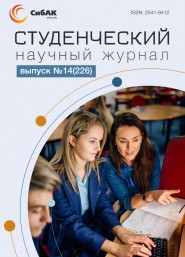Статья опубликована в рамках: Научного журнала «Студенческий» № 14(226)
Рубрика журнала: Математика
Скачать книгу(-и): скачать журнал часть 1, скачать журнал часть 2, скачать журнал часть 3, скачать журнал часть 4, скачать журнал часть 5
METHODICAL SYSTEM FOR STUDYING A LINEAR FUNCTION IN BASIC SCHOOL
ABSTRACT
This article is devoted to the methodological system of studying linear functions in the primary school.
The result of this discussion is the systematization of the accumulated material on this issue
Keywords: methodology, competitive pairs, functions, justification.
School mathematics is not a science, but a subject whose main goal is to study real situations using mathematical models. The primary mathematical model is a function that is the core of the school mathematics course. It allows you to establish a variety of connections in teaching both algebra and geometry. In a modern school course in mathematics, the leading approach is considered to be genetic with the addition of logical elements. The formation of concepts and ideas, methods and techniques as part of a functional line in the education system is built in such a way that students' attention is focused on:
- selected and fairly clearly demarcated representations associated with the function;
- establishing their interaction when deploying educational material.
Directly at the level of the educational process, within the framework of studying a certain section of the mathematics course, the teacher develops a methodological system. The methodological system at the procedural level includes the definition of the goal, the formulation of the educational task of the lesson and the formation of the content of the educational material. For the first time a linear function is introduced in the 7th grade in the course of algebra after studying linear equations with two variables and is considered as a relationship between variables.
For the first time a linear function is introduced in the 7th grade in the course of algebra after studying linear equations with two variables and is considered as a relationship between variables. To introduce the concept of a linear function, the following stages can be distinguished:
Preparatory stage: associated with the aspect of unambiguity in the concept of "Function". The goal is to introduce the idea of solving a linear equation in two unknowns. We use an example of solving a learning problem through the introduction of two variables in a traditional explanatory and illustrative way. The term "solve an equation" is also explained to students - it means to indicate all its possible solutions.
2. Isolation of the concept of a function "in its pure form". Students are tasked with understanding the text and relating its content to their experience. The text offered to students is devoted to the concept of a linear function, it formulates the definition of a linear function, k and m are arbitrary numbers.
3. Specificity of the concept of a linear function. Once students have identified aspects of linearity and dependency, they are encouraged to look at the role of linear dependency in relation to a linear equation. In the proposed task, it is required to restore a linear equation according to a given dependence, and find that functions of the form y \u003d f (x) allow you to find solutions to a whole class of linear equations. The main difficulty, in fact, lies in the fact that you need to understand that you need to solve the problem inverse to the one that was solved when looking for a way to find solutions to a linear equation with two unknowns.
4. Correlation between geometric and analytical methods for defining a linear function. The first step is the introduction of a geometric way of representing solutions of a linear equation in two unknowns. Since students were faced with the fact that it was required to show all solutions of a linear equation with two unknowns, they can rely on knowledge about the form of the graph. The main difficulty is to find the optimal way to plot.
5. The introduction of the concept of increasing and decreasing functions begins with the introduction of an algebraic way of describing the graph of a function. Now the students have to solve a problem in which, according to the proposed solutions, it is required to write down several more.
6. Concretization of the concept of a linear function. At this step, the solution of the training problem is performed, in which the question of concretizing the concept of function is considered.
The above approach to the study of a linear function in school does not cover the whole variety of ways and methods of studying this concept. They are only the main, most developed approach to the question of studying a linear function according to the textbook by A.G. Mordkovich.
References:
- Bellman, R. Introduction to the theory of matrices. M.: Nauka, 1978. - 351s.
- Borut, A., Ronchka, R. The theory of representations of groups and its applications. Volumes 1-2. M.: Mir, 1980.
- Weil, G. Classical groups, their invariants and representations.-M.: Gosizdan, 1947. – 48s.
- Viberg, E.B. Linear representation of groups. - M.: Nauka, 1985. – 144s.
- Mordkovich A.G. Algebra 7th grade. At 2 p.m. Part 1. Textbook for students of educational institutions / A.G. Mordkovich. - 17th ed., add. - M: Mnemosyne, 2020 . - 175 p.: ill.


Оставить комментарий